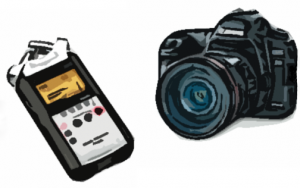DualEyes – purchased

DualEyes: It's a product with an awful name, but I look forward to the time it will save me. Ever since I got my Canon 7D I have been recording "dual system sound" where sound is recorded on-camera and externally with a Rode NTG-3 shotgun mic connected to a digital recorder. Why record the sound twice? The 7D's tiny built-in microphone is saddled with really bad (that's bad "bad", not good "bad") Automatic Gain Control (AGC). That means that when nobody is speaking the gain is turned up really high because the camera is trying to capture very quiet sounds like whispering or puppies snoring. The problem is when someone speaks after a period of silence the gain is turned up really high, then it quickly turns down so that it is appropriate for the dialog, then cranks up really high when (s)he stops talking. The silence between bits of dialog have a high "noise floor" and makes it sound like a home movie. Nothing professional about that. Recording the dialog on an external digital recorder is preferable because the gain can be set for a particular scene. The sound recordist gets a feel for how loud the scene is going to be and adjusts the gain on the microphone manually.
This is all fine and dandy until it is time to edit the footage. For every video clip there is now another sound clip that must be manually lined up with it in the video editing software. If it isn't lined up then the spoken words don't match the moving lips and that's even less professional than sound with AGC. So I have spent hours lining up audio clips with corresponding video clips. Hours of my life wasted in this non-creative grunt work process. That is now behind me. DualEyes (again, AWFUL name) will take those video clips and external audio files and line them up for me. Select the files, click the button, have a nice cup of tea, and revel in the fact that the grunt work is being done by the computer instead of me.